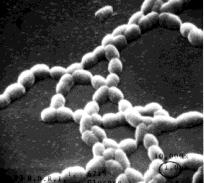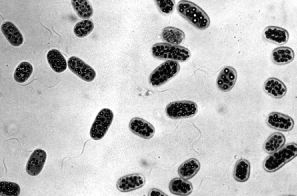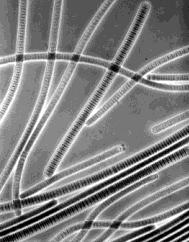
What are Bacteria?Bacteria are microscopic organisms whose single cells have neither a membrane-enclosed nucleus nor other membrane-enclosed organelles like mitochondria and chloroplasts. Another group of microbes, the archaea, meet these criteria but are so different from the bacteria in other ways that they must have had a long, independent evolutionary history since close to the dawn of life. In fact, there is considerable evidence that you are more closely related to the archaea than they are to the bacteria! [View]
|
Index to this page
|
| Link to illustrated discussion of the structure. |
 |
| Gram-positive bacteria are encased in a plasma membrane covered with a thick wall of peptidoglycan. Gram-negative bacteria are encased in a triple-layer. The outermost layer contains lipopolysaccharide (LPS). |
More recently, genome sequencing, especially of their 16S ribosomal RNA (rRNA), has provided additional insights into the evolutionary relationships among the bacteria.
Comparison of their sequenced genomes reveals that all the Gram-positive rods and cocci as well as the mycoplasmas belong to a single clade that has been named the Firmicutes.
C. tetani liberates a toxin that blocks transmitter release (by destroying the SNAREs needed) at inhibitory synapses in the spinal cord and brain. This interferes with the reciprocal inhibition of antagonistic pairs of skeletal muscles so the victim suffers violent muscle spasms. Fortunately, the disease — called tetanus — is now rare in developed countries, thanks to almost universal immunization against the toxin. Chemical alteration of the toxin produces a toxoid that still retains the epitopes of the toxin. Incorporated in a vaccine, the toxoid provides a relatively long-lasting (~10 years) immunity against tetanus.
 The bacteria in this group grow in characteristic colonies.
The bacteria in this group grow in characteristic colonies.
Many cases of "food poisoning" are caused by staphylococci.
Streptococci cause
| How pneumococci enter the body. |
| Streptococcus pneumoniae is the organism that led to the discovery that genes are DNA. Link to a discussion. |
Mycoplasmas have the distinction of being the smallest living organisms. They are so small (0.1 µm) that they can be seen only under the electron microscope.
Mycoplasmas are obligate parasites; that is, they can live only within the cells of other organisms. They are probably the descendants of Gram-positive bacteria who have lost their peptidoglycan wall as well as much of their genome — now depending on the gene products of their host.
The DNA sequences of the complete genomes of seven mycoplasmas have been determined, includingThe scientists at The Institute for Genomic Research (now known as the J. Craig Venter Institute — JCVI) who determined the Mycoplasma genitalium sequence followed this work by systematically destroying its genes (by mutating them with insertions) to see which ones are essential to life and which are dispensable. Of the 485 protein-encoding genes, they have concluded that only 381 of them are essential to life.
Workers at the JCVI have also succeeded in synthesizing the complete genome of one species of mycoplasma, inserted this into a second species, which converted the second species into the first. Read more about this remarkable achievement.
Most of these Gram-positive organisms grow as thin filaments — like a mold — rather than as single cells. In fact, they were long thought to be fungi and were called actinomycetes. But fungi are eukaryotes and the actinobacteria are not.
Actinobacteria dominate the microbial life in soil where they play a major role in the decay of dead organic matter. Many of them have turned out to be the source of valuable antibiotics, including streptomycin, erythromycin, and the tetracyclines.
Its genome contains 4,411,532 bp of DNA encoding some 3,959 genes.
| How the tubercle bacillus enters and lives in cells. |
Although a close relative of M. tuberculosis (they share 1,439 genes), much of its DNA encodes pseudogenes, genes that no longer make a functional product. M. leprae is an obligate intracellular parasite; it has never been cultured in vitro. This is probably because it has abandoned many of the genes needed for an independent existence choosing instead to depend on the genes of its host cell.
Treatment of the toxin with formaldehyde converts it into a harmless toxoid. Immunization with this toxoid — usually incorporated along with tetanus toxoid and pertussis antigens in a "triple vaccine" (DTP) — protects against the disease.
They are further subdivided into 5 clades: alpha-, beta-, gamma-, delta-, and epsilon proteobacteria.
| Link to discussion of the endosymbiotic theory of the origin of mitochondria. |
| Link to data on genomes of R. prowazekii and mitochondria. |
| Link to discussion. |
Certain colorless bacteria share the ability of chlorophyll-containing organisms to manufacture carbohydrates from inorganic raw materials, but they do not use light energy for this. These so-called chemoautotrophic bacteria secure the necessary energy by oxidizing some reduced substance present in their environment. The free energy released by the oxidation is harnessed to the manufacture of food.
For example, some chemoautotrophic sulfur bacteria oxidize H2S in their surroundings (e.g., the water of sulfur springs) to produce energy:2H2S + O2 → 2S + 2H2O; ΔG = -100 kcal
They then use this energy to reduce carbon dioxide to carbohydrate (like the photosynthetic purple sulfur bacteria).2H2S + CO2 → (CH2O) + H2O + 2S
These chemoautotrophs are responsible for the brownish scale that forms inside the tanks of flush toilets. They complete the oxidation of partially oxidized iron compounds and are able to couple the energy produced to the synthesis of carbohydrate.
This chemoautotroph oxidizes NH3 (produced from proteins by decay bacteria) to nitrites (NO2−). This provides the energy to drive their anabolic reactions. The nitrites are then converted (by other nitrifying bacteria) into nitrates (NO3−), which supply the nitrogen needs of plants.
| Link to discussion of the various roles that bacteria play in the nitrogen cycle. |
Causes meningococcal meningitis, an extremely serious infection of the meninges that occasionally occurs in very young children and in military camps. There is a vaccine that is effective against several strains but unfortunately not the most dangerous one.
| How N. gonorrhoeae evades host immunity. |
The largest and most diverse subgroup of the proteobacteria.
Some examples| How Salmonella typhi gets into human cells. |
| S. typhimurium in the Ames Test |
| Read about the 1991–92 cholera epidemic in Central and South America that made over 700,000 people ill and caused over 6,000 deaths. |
The recurrent epidemics of the "black death" in Europe from 1347–1351, which killed off at least 30% of the population, was caused by this organism. DNA sequencing of samples retrieved from the bodies of plague victims of that era confirm this diagnosis.
Although no major epidemics have occurred in this century, the threat is not entirely over. Yersinia pestis still flourishes in some rodent populations in the western U. S. and causes a dozen or so cases of human plague — primarily among small game hunters — each year.
Like green plants, these bacteria are photosynthetic, using the energy of sunlight to reduce carbon dioxide to carbohydrate. Unlike plants, however, they do not use water as a source of electrons.

Instead they use hydrogen sulfide to supply the electrons needed to synthesize NADPH and ATP.
2H2S + CO2 → (CH2O) + H2O + 2S
In the process, they produce elemental sulfur (often — as seen in this photomicrograph of Chromatium — stored as granules within the cell). [Image from H. G. Schlegel and N. Pfennig, Arch. Microbiol. 38[1], 1961.]
Photosynthetic bacteria contain special types of chlorophylls (called bacteriochlorophylls) incorporated into membranes. With this machinery, they can run photosystem I but not photosystem II (which explains their inability to use water as a source of electrons).| Link to a discussion of green plant photosynthesis and photosystems I and II. |
A diverse group that includes Bacteroides fragilis, one of the most abundant organisms in the human large intestine. It has been estimated that these Gram-negative anaerobes make up >30% of the dry weight of human feces. While they can be pathogenic elsewhere in the body, they live as commensals in the intestine digesting otherwise-indigestible polysaccharides and providing us with some fatty acids, sugars, and perhaps vitamin K.
These are thin, corkscrew-shaped, Gram-negative flexible organisms that range in length from a few to as many as 500 µm.
Two notorious examples:
Both these organisms have had their complete genomes sequenced. [Link]
Chlamydiae are also obligate intracellular parasites (they cannot make their own ATP).
Its genome contains 1,042,519 bp of DNA encoding 894 genes.
In 2008, over 1.2 million cases were reported in the U. S., and this is probably only half of the true total. The infection is usually spread by sexual intercourse making it the most common sexually-transmitted disease (STD). It is easily cured if diagnosed, but many infections remain untreated and, in females, are a major cause of pelvic inflammatory disease. This causes scarring of the uterus and fallopian tubes and often results in infertility.Mothers can pass the infection on to their newborn babies causing serious eye disease and pneumonia. To avoid this, pregnant women are usually tested for chlamydia and treated with antibiotics if they are infected.
Several million people in the desert regions of Asia, Africa, and the Near East have been blinded by trachoma. This eye infection is caused by a strain of C. trachomatis (and is responsible for its name).
 Unlike other photosynthetic bacteria, cyanobacteria
Unlike other photosynthetic bacteria, cyanobacteria
CO2 + 2H2O → (CH2O) + H2O + O2
It is estimated that cyanobacteria are responsible for ~ 25% of the photosynthesis occurring on our planet.
The micrograph is of Oscillatoria, a filamentous cyanobacterium (magnified about 800 times). Each disk in the chains is one cell.
Cyanobacteria also contain two antenna pigments:These two pigments also occur in red algae. Their chloroplasts (in fact probably all chloroplasts) evolved from an endosymbiotic cyanobacterium.
| Link to a discussion of the endosymbiosis theory of the origin of eukaryotes. |
Why are the Gram-negative bacteria encased in two membranes while the Gram-positives have only one? Evolutionary biologist James Lake has proposed that the Gram-negatives arose by one single-membrane bacterial ancestor engulfing another. His analysis of many genes in the various bacterial groups indicate that the most probable ancestors of this possible endosymbiosis were a clostridium and an actinobacterium. Clostridia are the only Gram-positive bacteria that have photosynthetic members and because the photosynthetic apparatus in all photosynthetic Gram-negative bacteria is in the inner membrane, perhaps the actinobacterium was the host and the clostridium the endosymbiont.
| Welcome&Next Search |